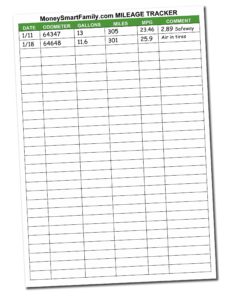How To Calculate Your Gas Mileage
This is an Easy Way to Save Money on Gas. It’s free and simple to use. Just write it down each time you fill your tank with gas at the gas station. Filling the entire tank each time is the best way to get accurate calculations.
By calculating your gas mileage each time you fill up, you’ll know if car trouble is possibly coming your way. If gas mileage goes down you might want to check your tires or perhaps it’s time for a tune-up.
We also record oil changes, tire inflations and other maintenance we have done on the car.
We’ve had copies of this Mileage Tracker Form in our cars for years and years, it helps us know how our engine is performing.
Use the formula below to calculate your gas mileage when you fill up your tank.
If we drove 325 miles and put in 14 gallons of gas, then 325 ÷ 14= 23.21 mpg. If our gas mileage goes down, we know it’s time to check our tires or maybe it’s time for a tune up. This helps us keep our cars in tip-top shape.
Miles or kilometers driven since last fill-up
divided by
gallons or liters used.
Get the Mileage Tracker Form Here – just give us your Email Address
A Real Life Mileage Story
Our daughter Becky drives a Toyota Tacoma. She doesn’t do much driving since her job is near our home, but whenever she fills her tank she always calculates her gas mileage on our Gas Mileage Tracker Card that she keeps in her car.
Recently she noticed that her mileage dropped from 20 mpg to 17. Her tire pressure should be 44 pounds of pressure (pounds per square inch—psi) and had dropped to 30 psi.
Now, a loss of 3 mpg doesn’t sound like much, but in reality, it’s a loss of 15% of her standard mileage. To calculate how much of a cost difference it really makes, we decided to see how 15% affected the cost of a gallon of gas.
Hold onto your seat, because it is quite significant.
If gas costs $3.50 per gallon a 15% loss in mileage means that a gallon of gas actually is costing her $4.02 per gallon or 52 cents more per gallon. That’s really not something we like doing!
Use this chart to see what you could be losing if your tires are under-inflated.
| Normal MPG | Loss of 10% | Addl Cost @$3.50 per Gal | Loss of 20% | Addl Cost @ $3.50 per Gal |
|---|---|---|---|---|
| 15 | -1.5 mpg | 35 cents | -3.0 mpg | 70 cents |
| 20 | -2.0 mpg | 35 cents | -4.0 mpg | 70 cents |
| 25 | -2.5 mpg | 35 cents | -5.0 mpg | 70 cents |
| 30 | -3.0 mpg | 35 cents | -6.0 mpg | 70 cents |
To calculate your gas mileage, fill your gas tank completely and record your odometer reading (total mileage on your car) or reset your trip meter.
The next time you fill up, calculate how many miles you’ve driven since your last fill up (subtract your current odometer reading from your previous one or just read your trip meter).
Record the number of gallons it takes to fill your tank and divide the miles driven by the number of gallons of gas you just added. That will give you your total gas mileage.
The bottom line is to monitor your gas mileage and your tire pressure on a regular basis. Doing this will get you the best gas mileage for your money.
More Gasoline and Car Savings
For more information about saving on car ownership and expenses, see the auto chapter of our first book, “America’s Cheapest family Gets You Right on the Money” or visit our Money Saving Tips Auto page.
Also be sure to watch our YouTube video, for an Arizona TV spot that talks all about saving money on gasoline for your car. Our Mileage tracker was featured on this TV spot!
_____
We’d love to hear from you about how you track your mileage. Please leave a comment below and include your city and state if you feel comfortable doing so.
